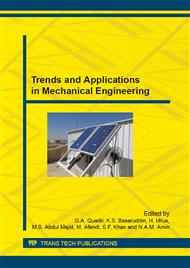[1]
R. Tovo, A damage-based evaluation of probability density distribution for rain-flow ranges from random processes, International Journal of Fatigue, vol. 22, p.425–429, (2000).
DOI: 10.1016/s0142-1123(00)00006-2
Google Scholar
[2]
Y. Liu and S. Mahadevan, Stochastic fatigue damage modeling under variable amplitude loading, International Journal of Fatigue, vol. 29, pp.1149-1161, (2007).
DOI: 10.1016/j.ijfatigue.2006.09.009
Google Scholar
[3]
H. Shen, J. Lin, and E. Mu, Probabilistic model on stochastic fatigue damage, International Journal of Fatigue, vol. 22, p.569–572, (2000).
DOI: 10.1016/s0142-1123(00)00030-x
Google Scholar
[4]
B. Echard, N. Gayton, and A. Bignonnet, A reliability analysis method for fatigue design, International Journal of Fatigue, vol. 59, p.292–300, (2014).
DOI: 10.1016/j.ijfatigue.2013.08.004
Google Scholar
[5]
S. Abdullah, J. A. Giacomin, and J. R. Yates, A mission synthesis algorithm for fatigue damage analysis, Proceedings of the Institution of Mechanical Engineers, Part D: Journal of Automobile Engineering, vol. 218, pp.243-258, (2004).
DOI: 10.1243/095440704322955786
Google Scholar
[6]
W. Li, T. Sakai, Q. Li, and P. Wang, Statistical analysis of fatigue crack growth behavior for grade B cast steel, Materials & Design, vol. 32, pp.1262-1272, (2011).
DOI: 10.1016/j.matdes.2010.09.036
Google Scholar
[7]
D. -S. S. J. -K. Kim, A statistical approach for predicting the crack retardation due to a single tensile overload, International Journal of Fatigue, vol. 25, pp.335-342, (2003).
DOI: 10.1016/s0142-1123(02)00145-7
Google Scholar
[8]
W. F. Wu and C. C. Ni, Statistical aspects of some fatigue crack growth data, Engineering Fracture Mechanics, vol. 74, pp.2952-2963, (2007).
DOI: 10.1016/j.engfracmech.2006.08.019
Google Scholar
[9]
E. Castillo and A. Fernández-Canteli, A unified statistical methodology for modeling fatigue damage, (2009).
DOI: 10.1007/978-1-4020-9182-7_7
Google Scholar
[10]
M. Nagode and M. Fajdiga, A general multi-modal probability density function suitable for the rainflow ranges of stationary random processes, International Journal of Fatigue, vol. 20, pp.211-223, (1998).
DOI: 10.1016/s0142-1123(97)00106-0
Google Scholar
[11]
R. I. Stephens, A. Fatemi, R. R. Stephens, and H. O. Fuchs, Metal Fatigue in Engineering, 2 ed. Canada: John Wiley & Sons, Inc, (2001).
Google Scholar
[12]
N. E. Dowling, Mechanical Behavior of Materials, 4th ed.: Pearson Education Limited, (2013).
Google Scholar
[13]
D. Benasciutti, Fatigue analysis of random loadings, Doctor of Philosophy, Department of Engineering, University of Ferrara, (2004).
Google Scholar


